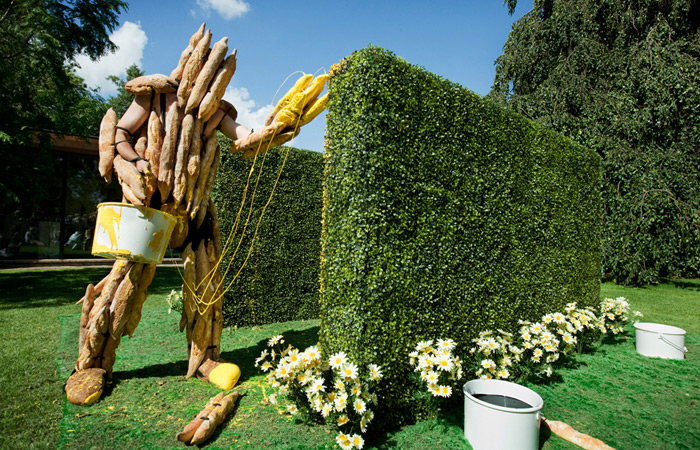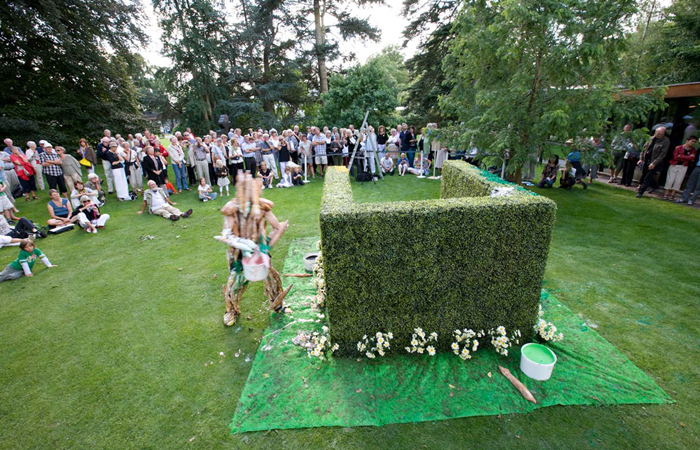Landscape painting by Søren Dahlgaard as The Dough Warrior in the park of Louisiana Museum of Modern Art, Denmark in 2008.
Anders Kold, curator at Louisiana Museum of Modern Art, was summoned to a café in Copenhagen in November 2007 to view and discuss the video Dough Warrior Painting His Garden, 2007 for the documentary film The Dough Warrior – a portrait of Søren Dahlgaard. The following excerpts are an abridged version of the recording:
“… It is a good argument for the view that art should not necessarily be anaemic or encumbered by solemnity. It’s acceptable to smile at the same time. And the Dough Warrior certainly calls for a smile! The way he moves around, humming quietly as if he were in the shower, while he carries out his work of painting small plots of land with vibrant colours. Yes, it is quite funny I must say…
… It says something about Søren Dahlgaard, about him specifically, but it also says a lot about an individual at a difficult time or place in history. These days there are many who paint, but only a few years ago in the year 2000 it was relatively “new”. I’m not saying that he painted at the time, but you must relate to it. Painting is in one way or another the history of art or a story within the history of art which we as individuals must either throw a lump of dough at, paint over or do something to. This is because it’s the strongest trend, and one that has been elevated by the state and collectors to the grandest within the old hierarchies…
… It’s obviously broken down and insulted many times, yet it continues to expand: Painting is the largest sour dough found in art, is it not? And Dahlgaard comments on it. I can’t help thinking about a conversation I had with the Danish painter Tal R in connection with his exhibition at Louisiana (2007), where he began by saying: ‘If you concentrate on the colours, you have lost as an artist’. At first it seems an extremely provocative statement coming from a painter, but it relates to what Dahlgaard is doing: Namely, to have an opinion about things. It’s not about subtle nuances and tones. Painting is a tool one must relate to. It has a history and in that story there is a critique of the medium – and Søren Dahlgaard has taken this on board.
… One could say it also points to another area the art world currently concentrates on, namely the artist. But what kind of figure is he then if art can be outlined to an extent that an informal conversation becomes the artwork? The romantic figure disappears completely – typically the male painter who staggers and fences with brushes. This figure has already been fiercely challenged and it is here, on the small plot of land, where the Dough Warrior treads. If he is unable to guide the brushes into the buckets of paint he merely lifts the bucket and paints. It is both comical and tragic, and is one of many stories portraying the difficulties of being an artist…
… So Søren Dahlgaard is not a sensitive painter. He is a conceptual artist, a man of ideas, and puts himself to use if the staging dictates it. The material must be worked though to create what will eventually become an image: In this case an image of what artists do. Artists take things and place them somewhere different, thus activating a significance or meaning that results in a dialogue or a testimony…
… Dahlgaard’s version cannot be executed too harshly, too simply or too clumsily. Therefore the artist figure – in this case the Dough Warrior – never gets anywhere as he struggles with and gets caught up in his medium which, just like his story, is sluggish. Art must, therefore, from time to time cut its own cord in order to progress: Allowing others to throw dough on you or to enter the arena and virtually destroy it through ineptitude may achieve this effect. In much the same way Peter Land dances naked in one of his video works, it is a performance you can laugh at and keep at arms length, and yet there is the potential for empathy and possibly even self-identification as another option. Perhaps Søren Dahlgaard feels like a Dough Warrior, perhaps he doesn’t. He appears to be a combination of human cannon ball and a very sensitive individual. He finds himself in the art system and has chosen dough as his medium but could just as well have been impeded in his quest by having brushes tied on his body. He is obviously troubled by history, yet his work is not decidedly political and maintains an acknowledgement of art, of artist and different models of existence as fundamental categories. At the same time his work is so wacky or distanced from reality that it cannot fail to bring at least a smile to one’s lips. But we don’t just sit and laugh at it …
… It’s a rather unique universe that runs along paths already trodden. To play the painter is not without precedent, but there is something reminiscent of Asian martial arts about it. Rather like a Ninja Turtle with baguettes tied on its body in an orderly fashion. For me, it relates to precisely what I sensed the first time I saw his work: Monitored from all sides, he was subjected to individuals flinging dough at him. Or a bunch of individuals, seated around a Piet Hein Super Ellipse table covered with a large, swollen mountain of dough, who looked as if extraterrestrial forces controlled them as they rhythmically banged their heads into the dough mass. Man, that was strange! The epitome of design exposed to anti-design in much the same way as Dahlgaard attacks the familiar categories – the artist, painting and art – with fearless idiocy…
… Dahlgaard’s work from 2000 to 2007 has strong lineage as he both performs the medium as well as discusses it. The dough has now been baked and is a kind of armour which makes it impossible to produce a classical painting as he is constantly impeded by rogue baguettes strapped to his elbows and arms.
…There are stories in the history of art that have since become myths because they have taken on a broader implication. For example that of the elderly Renoir, who was so riddled with arthritis that he tied brushes to his hands in order to paint. This leads me to recall another work of art that has often been exhibited at Louisiana; Paul McCarthy’s The Painter. Dressed as a kind of art spastic he paints just as much with his penis and his bottom as he does with his hands. At the same time he staggers around like a paralysed armoured beetle in relation to collectors and gallerists. This primitive animal is in McCarthy‘s work an obvious mocking of the sensitive and the expressive in the arts and its institutions…
… If you purchase a painting regarded in every respect as a failure, possibly even with integral breadcrumbs, it’s not intended to hang next to a composition by a stern modernist, like the Dane Edvard Weie for instance. Rather, one purchases it as an acknowledgement and an appreciation of the nature of the concept. For although the artwork must remain within – i.e. acknowledge – the boundaries of the canvas, the piece will sneer at Weie and portray something that lies outside or beyond the object in question. Instead of e.g. wading through the plot of land adorned in bread, the Dough Warrior could just as well have burned it with a flamethrower or something similar. In any case with an obvious reference to Yves Klein, perhaps. It all takes place in the mind, in the communication between the artwork and the spectator. So, we have a heavyweight industry and a brain industry…
… The work is very strictly conceived and executed. Performance art demands that. If a painter in the classical sense works for hundreds of hours to complete a work of art, regardless of whether the colouristic or the structural is at the fore, Dahlgaard could spend an equal amount of time on his work. What we cannot see in the two minutes on the screen are 100 hours of conceptualizing the dramaturgy of the performance as a whole. It must look exactly this way and unfold inside the scenario in that way for him to finally have control over his body. Like a ballet dancer, he must know exactly what to do next, despite his movements not resembling those of a ballet dancer in the slightest way. And the whole thing is created with the very same incisive precision employed by the painter when adding paint to a canvas. It’s just another register of human acknowledgment or senses to which Dahlgaard’s art addresses itself. In much the same way the purchase of a painting tends to demand a minimum of respect for craftsmanship and originality of some sort, and therefore treats it as a fetish, in Dahlgaard’s case one must also appreciate (and value) the hidden work and the originality as something fundamental and honest. Even if the work can be interpreted as ironic to the idea of an especially privileged sensitivity. His statement is relevant, like so much else, but there are not many of his kind – which may ultimately be of benefit to societal cohesion…
… I believe that the mixture of invention and disciplined action characterizes him, and it is not an exhibitionist desire to once again see Dahlgaard fuck up or Dahlgaard make the cut. He has a message, which is not as easy as one might think. Sometimes one has to speak harshly to others in order to get an honest answer. If you look at it from a universal, human level, one can imagine all sorts of psychological processes whereby we could make others say things they really mean. Artists work in a field of self-realization, but also with a desire to escape from themselves. This is what I meant by saying Dahlgaard is not an exhibitionist…
…To throw light on a discussion and move it to a place where it can be viewed from several angles is how one might take a bearing on Dahlgaard’s many arenas and markets – privet square inclusive. Obvious it would seem when one uses one’s own body and performs, but it can be done in 101 different ways. Therefore, I believe he is fundamentally an artist concerned with dialogue. This is more than a mockery of painters. Neither is it about how to make a name for oneself and make money, but rather how he actually expresses his inner thoughts. Should implements be utilized or should I write texts? Should I paint or do I need to somehow create an alter ego who I can push so far that others can relate to it? To a place where everyone becomes more intelligent…






